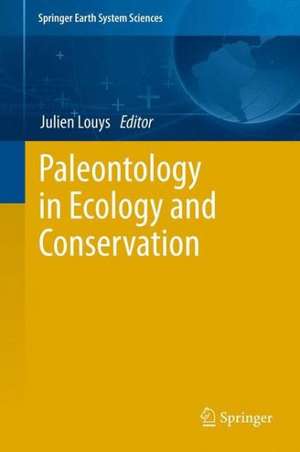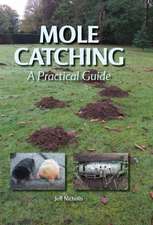Paleontology in Ecology and Conservation: Springer Earth System Sciences
Editat de Julien Louysen Limba Engleză Paperback – 9 mai 2014
| Toate formatele și edițiile | Preț | Express |
|---|---|---|
| Paperback (1) | 639.73 lei 6-8 săpt. | |
| Springer Berlin, Heidelberg – 9 mai 2014 | 639.73 lei 6-8 săpt. | |
| Hardback (1) | 645.79 lei 6-8 săpt. | |
| Springer Berlin, Heidelberg – 26 apr 2012 | 645.79 lei 6-8 săpt. |
Din seria Springer Earth System Sciences
- 18%
 Preț: 1023.74 lei
Preț: 1023.74 lei - 18%
 Preț: 1405.09 lei
Preț: 1405.09 lei - 18%
 Preț: 953.65 lei
Preț: 953.65 lei - 18%
 Preț: 888.18 lei
Preț: 888.18 lei - 15%
 Preț: 653.00 lei
Preț: 653.00 lei - 18%
 Preț: 1394.03 lei
Preț: 1394.03 lei - 18%
 Preț: 897.65 lei
Preț: 897.65 lei - 18%
 Preț: 997.83 lei
Preț: 997.83 lei -
 Preț: 386.22 lei
Preț: 386.22 lei - 15%
 Preț: 642.03 lei
Preț: 642.03 lei - 15%
 Preț: 639.73 lei
Preț: 639.73 lei - 24%
 Preț: 804.32 lei
Preț: 804.32 lei - 15%
 Preț: 642.51 lei
Preț: 642.51 lei - 15%
 Preț: 640.24 lei
Preț: 640.24 lei - 18%
 Preț: 1244.89 lei
Preț: 1244.89 lei - 15%
 Preț: 646.30 lei
Preț: 646.30 lei - 20%
 Preț: 586.47 lei
Preț: 586.47 lei - 18%
 Preț: 733.46 lei
Preț: 733.46 lei - 18%
 Preț: 1229.73 lei
Preț: 1229.73 lei - 15%
 Preț: 641.53 lei
Preț: 641.53 lei - 20%
 Preț: 578.60 lei
Preț: 578.60 lei - 24%
 Preț: 819.28 lei
Preț: 819.28 lei -
 Preț: 374.37 lei
Preț: 374.37 lei - 24%
 Preț: 680.55 lei
Preț: 680.55 lei - 20%
 Preț: 576.85 lei
Preț: 576.85 lei - 18%
 Preț: 973.56 lei
Preț: 973.56 lei - 24%
 Preț: 829.71 lei
Preț: 829.71 lei - 15%
 Preț: 639.90 lei
Preț: 639.90 lei - 15%
 Preț: 695.85 lei
Preț: 695.85 lei - 18%
 Preț: 948.92 lei
Preț: 948.92 lei - 18%
 Preț: 958.38 lei
Preț: 958.38 lei - 24%
 Preț: 789.36 lei
Preț: 789.36 lei - 18%
 Preț: 956.99 lei
Preț: 956.99 lei - 24%
 Preț: 799.20 lei
Preț: 799.20 lei - 20%
 Preț: 569.00 lei
Preț: 569.00 lei - 15%
 Preț: 637.28 lei
Preț: 637.28 lei - 15%
 Preț: 634.82 lei
Preț: 634.82 lei -
 Preț: 408.86 lei
Preț: 408.86 lei
Preț: 639.73 lei
Preț vechi: 752.63 lei
-15% Nou
Puncte Express: 960
Preț estimativ în valută:
122.41€ • 128.15$ • 101.29£
122.41€ • 128.15$ • 101.29£
Carte tipărită la comandă
Livrare economică 05-19 aprilie
Preluare comenzi: 021 569.72.76
Specificații
ISBN-13: 9783642440984
ISBN-10: 3642440983
Pagini: 284
Ilustrații: X, 274 p.
Dimensiuni: 155 x 235 x 15 mm
Greutate: 0.4 kg
Ediția:2012
Editura: Springer Berlin, Heidelberg
Colecția Springer
Seria Springer Earth System Sciences
Locul publicării:Berlin, Heidelberg, Germany
ISBN-10: 3642440983
Pagini: 284
Ilustrații: X, 274 p.
Dimensiuni: 155 x 235 x 15 mm
Greutate: 0.4 kg
Ediția:2012
Editura: Springer Berlin, Heidelberg
Colecția Springer
Seria Springer Earth System Sciences
Locul publicării:Berlin, Heidelberg, Germany
Public țintă
ResearchCuprins
Palaeontology and ecology – their common origins and later split.- Ecology needs a palaeontological perspective.- Reconciling Paleontological and Neontological Data: Issues of Scale, Taxonomy, and Taphonomy.- Building links between ecology and palaeontology with taphonomic studies of recent vertebrate communities.- Phylogeography and the fossil record.
Recenzii
From the reviews:
“This book is aimed at researchers working in ecology and conservation who are interested in making use of the vast amount of information stored within the fossil record. The greatest strength of the book is that it teaches conservation planners how to access the vertebrate paleontological record, in order to extract the long-term demographic data that they require. … it provides the building blocks required in order to achieve greater integration between palaeo- and neo-ecology and conservation biology … .” (Elizabeth S. Jeffers, Frontiers of biogeography, Vol. 5 (1), 2013)
“This book is a must read for ecologists interested in biodiversity and the impact that human populations are having on the environment. Louys … has done a superb job of pulling together papers that highlight the interaction between the fields of paleontology and ecology. … Valuable for all ecologists and students in paleontology (earth sciences) and ecological studies, as well as students and faculty with an interest in biodiversity. Summing Up: Highly recommended. Students of all levels, researchers/faculty, and professionals/practitioners.” (T. A. Franz-Odendaal, Choice, Vol. 50 (4), December, 2012)
“This book is aimed at researchers working in ecology and conservation who are interested in making use of the vast amount of information stored within the fossil record. The greatest strength of the book is that it teaches conservation planners how to access the vertebrate paleontological record, in order to extract the long-term demographic data that they require. … it provides the building blocks required in order to achieve greater integration between palaeo- and neo-ecology and conservation biology … .” (Elizabeth S. Jeffers, Frontiers of biogeography, Vol. 5 (1), 2013)
“This book is a must read for ecologists interested in biodiversity and the impact that human populations are having on the environment. Louys … has done a superb job of pulling together papers that highlight the interaction between the fields of paleontology and ecology. … Valuable for all ecologists and students in paleontology (earth sciences) and ecological studies, as well as students and faculty with an interest in biodiversity. Summing Up: Highly recommended. Students of all levels, researchers/faculty, and professionals/practitioners.” (T. A. Franz-Odendaal, Choice, Vol. 50 (4), December, 2012)
Textul de pe ultima copertă
The fossil record contains unique long-term insights into how ecosystems form and function which cannot be determined simply by examining modern systems. It also provides a record of endangered species through time, which allow us to make conservation decisions based on thousands to millions of years of information. The aim of this book is to demonstrate how palaeontological data has been or could be incorporated into ecological or conservation scientific studies. This book will be written by palaeontologists for modern ecologists and conservation scientists. Manuscripts will fall into one (or a combination) of four broad categories: case studies, review articles, practical considerations and future directions. This book will serve as both a ‘how to guide’ and provide the current state of knowledge for this type of research. It will highlight the unique and critical insights that can be gained by the inclusion of palaeontological data into modern ecological or conservation studies.
Caracteristici
First palaeontology book directly addressing both ecology and conservation science Provides both case-studies and review articles, allowing readers to know what has been done and how it has been done Includes an outlook chapter with future directions in ecology/conservation issues Includes supplementary material: sn.pub/extras
















